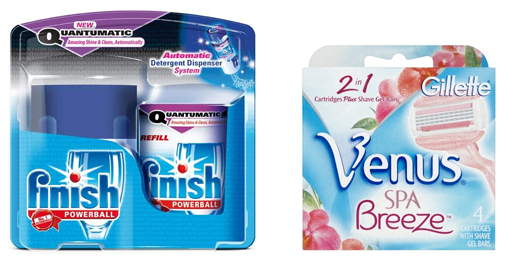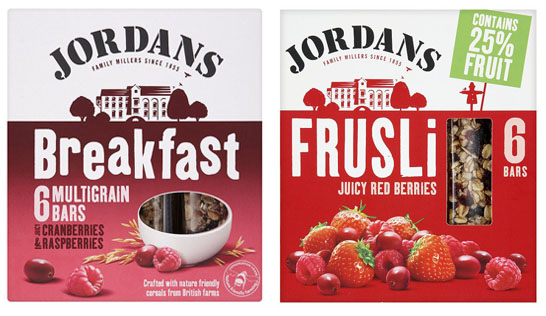![]() By Caroline Hagen
By Caroline Hagen
Time and time again we see companies investing large sums of money and resource into bringing a great consumer, benefit led innovation to market. But despite all projections and research that it will be a sure fire winner, it performs badly and doesn’t achieve the budgeted sales. So what’s going wrong?
More often than not the problem is that the consumer just doesn’t ‘get it’. They don’t understand the innovation. This is because the reason to believe is not being communicated and/or the benefits of the new product over and above the consumer’s current choice are not coming across.
Here are a couple of great examples:

RTB: better clean & shine RTB: no need to buy shaving gel
Any new innovation has to be able to communicate its key reason to be purchased at the point of decision making. To be heard among all the ‘marketing noise’, the innovation’s main persuader or killer point should be simple and easy to understand, pretty much instantly. This is due to the constant bombardment of marketing messages we receive nowadays. We have had to adopt a brutal editing system to quickly assess what is worthy of our attention – and what is not. So if the messages can’t be understood quickly and easy, then we (as consumers) are far less willing to put the effort in to work them out. Thus a compelling and simple argument for purchase has become absolutely vital.
So what tricks companies into mistakenly thinking consumers understand their brilliant, new innovation when, in fact, they actually don’t?
- Often companies don’t understand that they’re just too close to their products and too deeply enthralled in their marketplace. They completely understand the nuances of the various products on offer from their brand and the competition. Consumers do not. For example, do you understand the difference between ‘made from concentrate’ or ‘not made from concentrate’ in the juice market? What does it mean? Does Innocent squeeze its fruit daily or ship it in pre-squeezed and frozen? Which brands actually freshly squeeze oranges daily in the UK? Unless you’re working in or have worked in the juices category, it’s unlikely that you would know. It is a fact that living and breathing your category often blinds you to ‘the bleedin obvious’.
- Usually the researcher and consumers are given 2 – 3 stimulus concept options (in the form of an image one side and a couple of explanatory paragraphs on the other) to dissect. Because the options are given as a fait d’compli they immediately limit lateral thinking and box in the boundaries of consideration. There isn’t the freedom to explore the various possibilities and potential solutions to help identify and explain what it is you’ve got. And it’s very rare for the researcher to be given the deep product and category knowledge to be able to facilitate a proper discussion. We have often seen focus groups where the moderator just states that they don’t know or don’t understand ‘the technicalities’. So instead, what’s delivered is the best that can be with the little information that was drip fed in.
- For the purpose of the consumer research usually a couple of paragraphs are compiled to describe the product concept. This is totally unrealistic and thus lulls companies into a false sense of security. At the point of purchase this will be one short sentence, if you’re lucky. Most of the time it will be the product descriptor and a claim or two. So giving consumers two paragraphs of explanation at research stage is likely to result in a false reading.
- The product communication is given far too little attention and not until the end of the innovation process. Usually the focus is and resources are spent on the product design, production technology and pack structure instead of the product idea communication. The on-shelf message is given – often too late – to an Assistant Brand Manager to ‘just get it done’. It gets rushed through with no time for proper thought, shoved into a focus group and off to artwork. Now that might be an extreme description but it happens far more regularly than you might think.
- In the case of any form of brand stretch, the design brief’s focus is recognisibility and not devaluing the mother brand’s visual equities – keep it in the close family. Of course this is important, but not at the expense of being able to make the argument to get a sale? It’s as though the thinking behind it is that the mother brand will carry it and ensure its survival – but it won’t and it doesn’t.
- At the research stage it’s virtually impossible for consumers to visualise a fixture and take into account their quick decision making that occurs at the point of purchase. They will often give a positive reaction to a product concept as they’re unaware of the full range of product options available at the point of purchase. A decision which seems easy and with limited choice is in reality a far more difficult one with lots more information to consider.
- Unless the product idea is visualised within the context of the brand architecture there is tendency for consumers to give a positive reaction. This would not be the case if they understood the bigger picture. When assessing a large brand range with consumers they will often ask why certain products exist within in a range and how they don’t seem to make sense. This is a common problem. The need for strong differentiated reasons to believe between products in a range is just as important as it is for a product being launched under a new brand.
What’s the difference?


In some instances ‘new & improved’ products would be a far better strategy than introducing another product into a range.
So what can you do to avoid creating a great new product that consumers don’t understand?!
- Start earlier, a lot earlier, in the innovation process. Think about and test how to communicate the key benefits in an easy to understand and compelling way.
- Wrap product ideas in graphics from day one. It will force you to understand the communication problems that need to be overcome. For example you may find that consumers initially cannot see any difference to what’s currently on the market. But by changing the product descriptor from the norm it causes a reassessment e.g. changing ‘polish’ (strong wood associations) to ‘multi-surface duster.’
- Try to work and play the idea around with people (an agency, family, friends) outside of your company that don’t understand your category in any great depth. Get them to interrogate you with ‘but whys?’. Identify all the information they don’t know and the myths that they think are truths about your category. Then sit back and take a look at your product idea through their eyes. What would it take to convince them that you have something unique and different? This will be a good starting point.
- When testing and refining a product idea with consumers, develop lots of possible product descriptors, benefits and claims for them to play with, interrogate and build upon. We often find that what we, and our clients, thought was the reason to believe, or main usage, in fact turns out to be something quite different but more compelling and powerful for the consumer. Also, you learn so much from all the various options that don’t work.
- Ensure the facilitator has been given a seriously in-depth education on the potential product benefits and how exactly they differ from the competition. Their conversation with consumers should be an empowered one and there shouldn’t be any ‘I don’t knows’. After the initial unprompted responses are obtained, the facilitator should educate and correct misconceptions to really progress respondents’ thinking and understanding. Only then can consumers help in explaining the product quickly and easily to others.
- Don’t use sentences that are too long or paragraphs describing the product idea and all its benefits. This is not a realistic way to assess consumer understanding of a concept. Instead, adopt the principle of using punchy, short copy that would be comfortable being used in on-shelf communication. It will ensure that you get true reactions. Everyone will be aware of the task and issues to solve and no one will be under any illusion.
- Ensure that a product idea is always visualised in branded graphics and considered in the context of not only the entire brand range or architecture but also the entire potential competition. It doesn’t have to be a full reconstruction of a fixture (very expensive) but samples can be placed on a table, standard shelves, kitchen top – anything that enables consumers to see their wider consideration environment.
To improve NPD success rates, more attention and importance should be given to product concept communication. These are absolutely linked. We know this, as we often have to help pick up the pieces of failed NPD and put it all back together again in a way that the consumer understands it. Follow the above principles and they will help minimise the chance of a failed NPD. No one wants to be involved in an innovation accident where the ambulance and surgeon have to be called. We’d all much rather be around to experience a joyous and successful brand or product birth instead.
